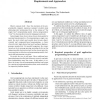Free Online Productivity Tools
i2Speak
i2Symbol
i2OCR
iTex2Img
iWeb2Print
iWeb2Shot
i2Type
iPdf2Split
iPdf2Merge
i2Bopomofo
i2Arabic
i2Style
i2Image
i2PDF
iLatex2Rtf
Sci2ools
JVA
2006
IEEE
2006
IEEE
Programming Models for Grid Applications and Systems: Requirements and Approaches
History repeats itself. Since the invention of the programmable computer, numerous computer scientists keep dedicating their professional lives to the design of “the single, best” programming model, whereas programmers “vote” by choosing their favourite languages and tools. Interestingly, these choices have always been guided by non-functional properties. For programming a single computer, the most widely used models have become objectoriented and component-based programming, a choice driven by their high abstraction level, leading to high programmer productivity. For parallel computers, the winner turned out to be message passing, providing by far not the highest-possible abstraction level, but the closest match between machine architecture and programming model, leading to efficient program execution. For grids, the race is still open. Here, additional nonfunctional properties like fault-tolerance, security, and platform independence enter the scene. In this paper, we explo...
Related Content
| Added | 12 Jun 2010 |
| Updated | 12 Jun 2010 |
| Type | Conference |
| Year | 2006 |
| Where | JVA |
| Authors | Thilo Kielmann |
Comments (0)

